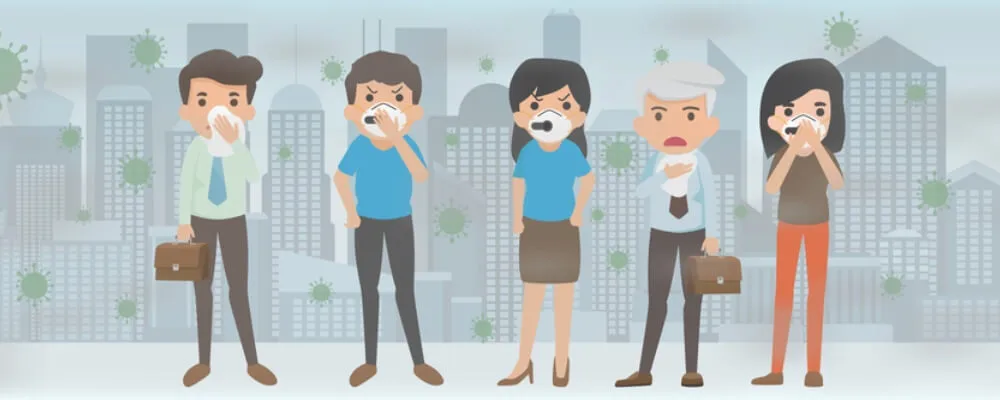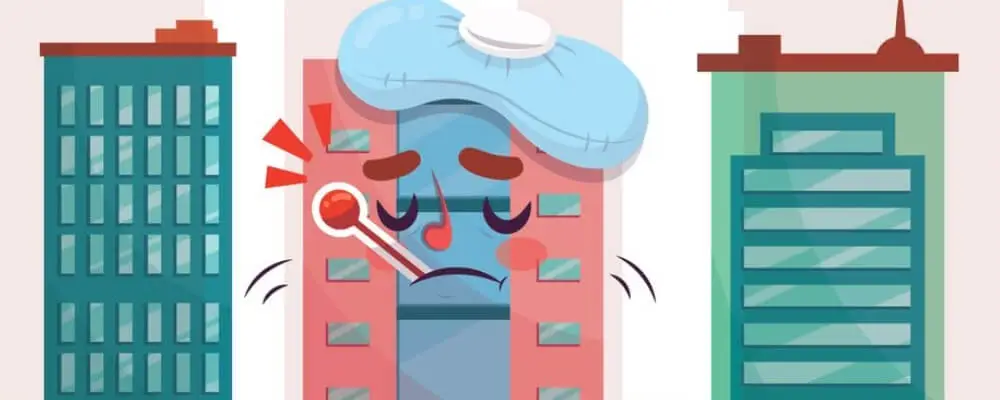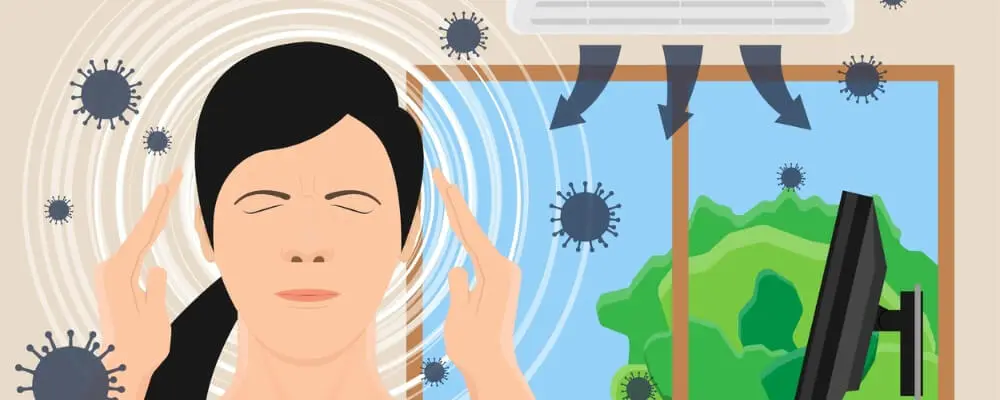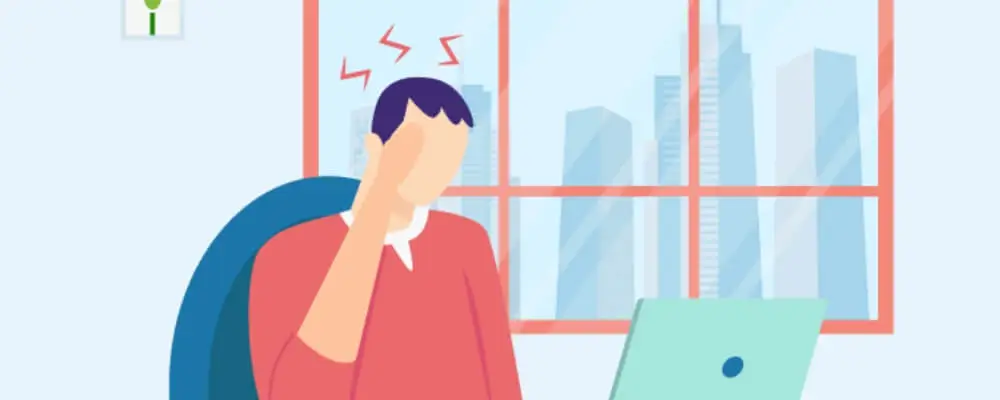In the heart of bustling cities and quiet suburbs, within concrete, glass, and brick walls lies an often overlooked health concern: Sick Building Syndrome (SBS). During the exteriors of modern structures project strength and innovation, the interiors can sometimes tell a different story — one of the occupants experiencing various health symptoms without an apparent cause.
In this blog, we will delve deep into the mysteries of SBS, unpacking its underlying causes, identifying its tell-tale signs, and offering strategies to combat its onset. Whether you’re an office worker, building manager, or a curious individual, this blog will equip you with the knowledge to understand and tackle this perplexing phenomenon, ensuring that our buildings remain sanctuaries of health and productivity. Join us as we journey through the corridors of SBS, shedding light on its shadowed corners.
What is Sick Building Syndrome?
Sick Building Syndrome is a medical condition where people in a building suffer from symptoms of illness or become unwell for no apparent reason. The symptoms are believed to be caused by the air quality within the building, but specific root causes are often difficult to identify.
These symptoms appear to increase in severity with the time people spend in the building and improve over time or even disappear when people are not there. Because of its broad range of symptoms, pinpointing a specific cause or solution can be challenging.
It’s important to distinguish SBS from other conditions where building occupants experience illness due to a specifically identified cause, such as exposure to asbestos or radon gas. By its very nature, SBS lacks a clear cause, making it both a challenging issue to address and a subject of much research and debate.
Factors contributing to SBS include inadequacies in heating, cooling, and ventilation and pollutants introduced by off-gassing from materials within the building or external sources. While these factors are often cited, the syndrome is not limited to them, and other environmental and job stressors may contribute. In essence, SBS represents a complex interplay between the building, its environment, its occupants, and occupational factors that require comprehensive evaluation to understand and mitigate.

Different Symptoms Of Sick Building Syndrome
Sick Building Syndrome (SBS) encompasses many non-specific symptoms that occupants may experience. Common symptoms include:
- Headaches: This is one of the most frequently reported symptoms by people affected by SBS. The constant exposure to certain pollutants or poor air quality may cause tension or migraine-type headaches.
- Fatigue or Lethargy: Individuals might feel persistent tiredness or lack of energy while in the building, not attributed to lack of sleep or other known health conditions.
- Concentration Difficulties or Mental Fog: This encompasses cognitive disruptions like memory issues, difficulty in focusing, or feeling mentally ‘slow’, potentially due to reduced oxygen levels or exposure to certain chemicals.
- Irritation of the Eyes, Leading to Dryness or Watering: The eyes may become red, itchy, and feel gritty. This could be due to irritants in the air, poor lighting, or inadequate humidity levels.
- Nasal Congestion or Runny Nose: Building contaminants can irritate the nasal passages, leading to symptoms resembling allergic reactions.
- Throat Irritation or Soreness: Dry or polluted air can cause a scratchy or sore throat. This can also be a response to microbes or chemical irritants in the environment.
- Dry, Itchy, or Flushed Skin: Certain individuals may develop skin reactions. Low humidity levels can dry out the skin, while certain chemicals may lead to allergic reactions or rashes.
- Nausea or Dizziness: These can be signs of a more severe reaction to pollutants, indicating a need for immediate attention. Inadequate ventilation or high levels of certain contaminants can lead to these symptoms.
- Sensitivity to Odors: Some people may become overly sensitive to odors present in the building, leading to headaches or respiratory symptoms.
- Shortness of Breath or Wheezing: A significant concern, this suggests that there might be contaminants affecting respiratory health, or that someone might be experiencing an allergic or asthmatic reaction.
- Coughing: Persistent coughing could be due to irritants present in the air, or a sign of respiratory distress.
- Dryness or Irritation of the Mucous Membranes (of the nose, mouth, etc.): The dryness or chemical irritants in the air can strip moisture from mucous membranes, leading to discomfort.
- General Malaise or Feeling Unwell without a Specific Identifiable Cause: A generalized feeling of unwellness, not tied to a specific symptom or known illness, is often reported in cases of SBS.
The recurrence of these symptoms upon re-entry into the building is a hallmark of SBS. When away from the potential building contaminants during breaks or vacations, individuals often feel better, only to have the symptoms return when they’re back in the building. This cyclical pattern, combined with the diverse symptoms among building occupants, makes pinpointing the exact cause and offering a definitive diagnosis challenging. However, understanding these symptoms in detail can guide building managers and health professionals in taking the necessary steps to improve building conditions and individual health.

Different Causes Of Sick Building Syndrome
Sick Building Syndrome (SBS) is thought to be caused by a combination of environmental, building-related factors, and individual sensitivities. Here are the various causes and contributing factors of SBS:
- Inadequate Ventilation: Historically, efforts to make buildings more energy-efficient led to reduced airflow, which can increase concentrations of pollutants. Poorly designed or maintained ventilation systems can trap pollutants inside.
- Chemical Contaminants from Indoor Sources: Building materials, office equipment, and cleaning agents can release volatile organic compounds (VOCs). Examples include formaldehyde from pressed wood products, cleaning agents and solvents, and office equipment emissions such as copiers. Gases like carbon monoxide can accumulate indoors, creating a toxic environment. Understanding the difference between carbon dioxide and carbon monoxide is crucial to managing indoor air quality effectively.
- Chemical Contaminants from Outdoor Sources: Outdoor pollutants can enter buildings through windows, vents, and other openings. Examples include vehicle exhaust, industrial emissions, and fumes from nearby sites using hazardous materials.
- Biological Contaminants: These include bacteria, molds, pollen, and viruses. They can breed in stagnant water that accumulates in ducts, humidifiers, or drain pans, or where water has collected on tiles, insulation, or carpets.
- Electromagnetic Radiation: Sources such as computers, cell phones, and other electronic devices can contribute to the symptoms, though research is ongoing.
- Poor Lighting: Insufficient lighting or glare can strain the eyes, while flickering from old fluorescent lighting can lead to headaches and eye discomfort.
- Temperature and Humidity Extremes: Too much variation in temperature and humidity levels can cause discomfort and exacerbate symptoms.
- Psychological Factors: Stress, dissatisfaction with the working environment, and poor interpersonal relationships or work pressures can contribute to the perception or severity of symptoms.
- Poor Ergonomic Design: Inadequate furniture design can cause or contribute to physical discomfort or health problems, which can be mistaken as symptoms of SBS.
- Airborne Particles: Dust, fibers, and other fine particles can be irritants, especially in sensitive individuals.
- Ozone: Equipment like photocopiers and printers can produce ozone, which, in higher concentrations, can be a lung irritant.
- Noise: A high noise level or continuous low-frequency noise can be a source of stress and discomfort.
- Water Contamination: In rare cases, contaminants from a building’s water supply, such as heavy metals or bacteria, could contribute to SBS.
It’s important to note that while any single factor can contribute to SBS, often, it’s a combination of multiple factors that result in the symptoms experienced by building occupants. Identifying and addressing the cause or causes in a particular building can be complex and might require a multifaceted approach.

How Can Sick Building Syndrome Be Prevented?
Preventing Sick Building Syndrome (SBS) often revolves around ensuring a healthy building environment. Addressing the root causes and potential triggers is the key. Here’s a detailed approach to preventing SBS:
1. Proper Ventilation
Ensuring heating, ventilation, and air conditioning (HVAC) systems meet the appropriate standards for the building’s purpose and its occupants is critical. Regular maintenance and cleaning, especially of filters, are necessary. This ensures adequate fresh air intake and helps reduce potential contaminants by minimizing air recirculation.
2. Regular Maintenance
Regular inspections, cleaning, and maintenance of all building systems are essential. This involves actively looking for and addressing any signs of mold, water damage, or issues with the HVAC systems.
3. Control Humidity
Maintaining indoor humidity levels between 30% and 60% is crucial. These levels not only prevent mold growth but also reduce the potential for mite infestations.
4. Minimize Indoor Pollutants
Opting for low-emission products, like certain paints, solvents, and cleaning agents, can significantly reduce indoor pollutants. It’s also vital to store chemicals, solvents, or pesticides in well-ventilated areas or outside the main building and to ensure proper ventilation when using products that emit VOCs.
5. Improve Cleaning Procedures
Implementing rigorous cleaning routines can help. Regular vacuuming using a HEPA filter-equipped vacuum reduces dust and particles. Moreover, thoroughly cleaning damp areas, such as kitchens and bathrooms, prevents mould and bacteria growth. Using less chemically-intense agents or ensuring spaces are well-ventilated can reduce the risk of SBS when cleaning.
6. Regular Building Inspections
Building inspections should be regular and thorough, looking for signs of mould, pests, or other contaminants. It’s important not to neglect hidden areas like basements or crawl spaces.
7. Ensure Good Lighting
Proper lighting is essential. Spaces must be well-lit to prevent eye strain, and issues like flickering lights should be addressed. Additionally, ensuring that screens are glare-free can reduce the risk of SBS symptoms related to eye strain.

8. Consider Building Materials and Furnishings
Selecting materials that have low VOC emissions can make a significant difference. Before installing new materials, like carpets or furnishings, airing them out, if possible, can reduce potential contaminants.
9. Manage Outdoor Pollutant Entry
The placement of air intake systems matters. They should be located away from pollution sources, like exhaust vents or busy roadways. If external contaminants are persistent, using air purifiers or filters can be beneficial.
10. Ensure Open Communication
Open communication lines with building occupants are a must. Encouraging them to promptly report any health concerns or issues with the building can help in early intervention. Additionally, educating them about SBS, its potential signs, and preventive measures can be invaluable.
Conclusion
I have learned a lot about Sick Building Syndrome, a complex issue requiring careful attention. Although our indoor spaces are meant to be comfortable and conducive to productivity, they can sometimes risk our health. It is important to recognize the symptoms, identify the causes, and take steps to prevent SBS so that our buildings can serve as safe havens. Since we spend so much time indoors, it is essential to prioritize our well-being and address any potential threats in our immediate environment.
This blog aims to equip readers with the necessary knowledge to tackle this challenge. As we end this journey, let us remember our ongoing responsibility to ensure healthy and happy indoor spaces for ourselves and future generations.

